
Crypto Jokes That Turned Into Serious Gains
Is Shiba Inu (SHIB) a joke? I don’t see anything funny about it. Can someone explain what we’re supposed to be laughing at? And if there’s nothing to laugh at, then how is it a joke?
What about BONK, MONA, PEPE, FLOKI, and other cryptocurrencies that are usually lumped into “crypto joke” lists? Can we really call them jokes? I don’t think so.
The query “Cryptocurrencies that took off from being jokes” seems simple and straightforward. But the results you get from a Google search or from ChatGPT make you seriously wonder: does the crypto market even have a sense of humor?
A Serious Question About Jokes
Why did I decide to write about this in the first place?
The thing is, we’re currently seeing something like a local altseason in the market:
- Bitcoin’s price showed decent growth and then paused
- The crowd is clearly buying altcoins instead of Bitcoin now — their growth continues and significantly outpaces Bitcoin’s gains
During periods like this, when nobody believes major cryptocurrencies have the potential to deliver massive returns, and everyone’s hunting for gems among lesser-known coins, the most unexpected and absurd crypto projects can suddenly explode.
The cryptocurrency market has seen this before.
So I got the idea to gather information about cryptocurrencies that were conceived simply as jokes — projects that nobody expected to grow at all, yet somehow managed to surge during altseasons.
My plan was: read up, dive deep, absorb the vibe, and then hit the market looking for current opportunities.
Instead, I got served up Baby Doge, Samoyedcoin, Hoge Finance, and their ilk. Nothing funny — nothing to absorb.
That’s when I decided to compile this list myself. To remember which cryptocurrencies I used to laugh at, and which ones ended up having the last laugh by showing explosive growth during altseasons.
Dogecoin (DOGE)
My list of jokes that exploded can’t skip the most iconic one — DOGE. Today it’s hard to understand what was so funny about it. But let’s travel back to 2013. Everyone involved in crypto back then believed this technology would change the world. Cryptocurrency was the greatest invention, a financial revolution.
Then suddenly, programmers Billy Markus and Jackson Palmer showed up and slapped a Shiba Inu dog logo from a popular meme onto this revolutionary technology. They showed everyone who took fintech so seriously that the technology itself wasn’t automatically revolutionary. You didn’t have to use it to store and transfer value. You could just as easily store and transfer digital doggies that nobody needed. It was a perfectly timed satire of Bitcoin fanboys’ seriousness.
The irony is that this joke coin gained real value: riding the wave of speculation, Dogecoin’s price skyrocketed tens of thousands of percent, reaching a market cap of $1 billion by early 2018, and $89 billion in May 2021.
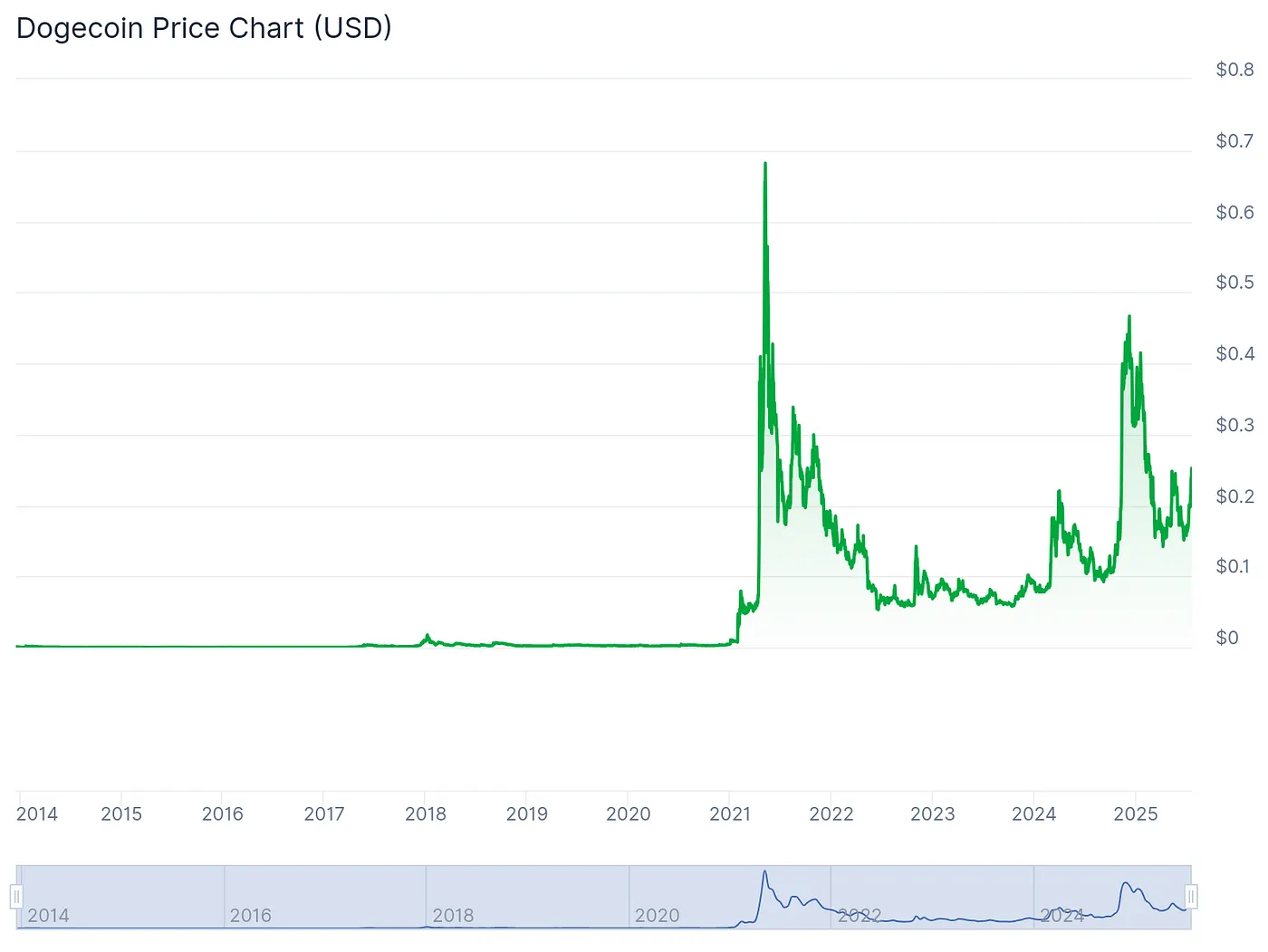
That last achievement wasn’t entirely organic — it was driven by attention from one of the world’s richest people, Elon Musk. But DOGE’s climb to a billion-dollar market cap happened without outside help. And while it looks like a tiny blip on the global chart (look at 2018), it was actually an incredible event.
PonziCoin (PONZI)
PONZI was a cryptocurrency with a brazenly provocative concept that mocked cryptocurrencies as financial pyramid schemes. Developer Rishab Hegde launched it in early 2018, positioning his token as “the world’s first legitimate Ponzi scheme.” In a tongue-in-cheek tone, he urged people to buy PONZI and actively “shill this coin to friends and family, like a complete sociopath.” Naturally, the project’s website openly warned that it was a scam, but that was exactly part of the humor — a commentary on the countless sketchy ICOs of that era. Surprisingly, people started investing so aggressively that the creator soon shut down the project, declaring that the joke had gone too far.
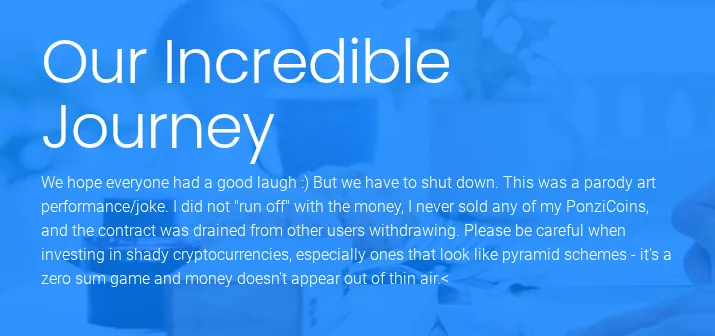
PonziCoin satirized crypto investors’ greed, their willingness to jump into any scheme, and their complete lack of common sense in chasing money out of thin air. But not everyone got it. At its peak, PONZI reached a market cap of $270,000 (nowhere near DOGE levels, but still — someone was buying these tokens, and not for pocket change).
Useless Ethereum Token (UET)
Another satirical project from the ICO boom era, aimed at mocking mindless token purchases. UET positioned itself as “the first 100% honest ICO,” openly declaring its own worthlessness. The token’s official website stated that it was “worth absolutely nothing,” with the added phrase “seriously, don’t buy these tokens.”
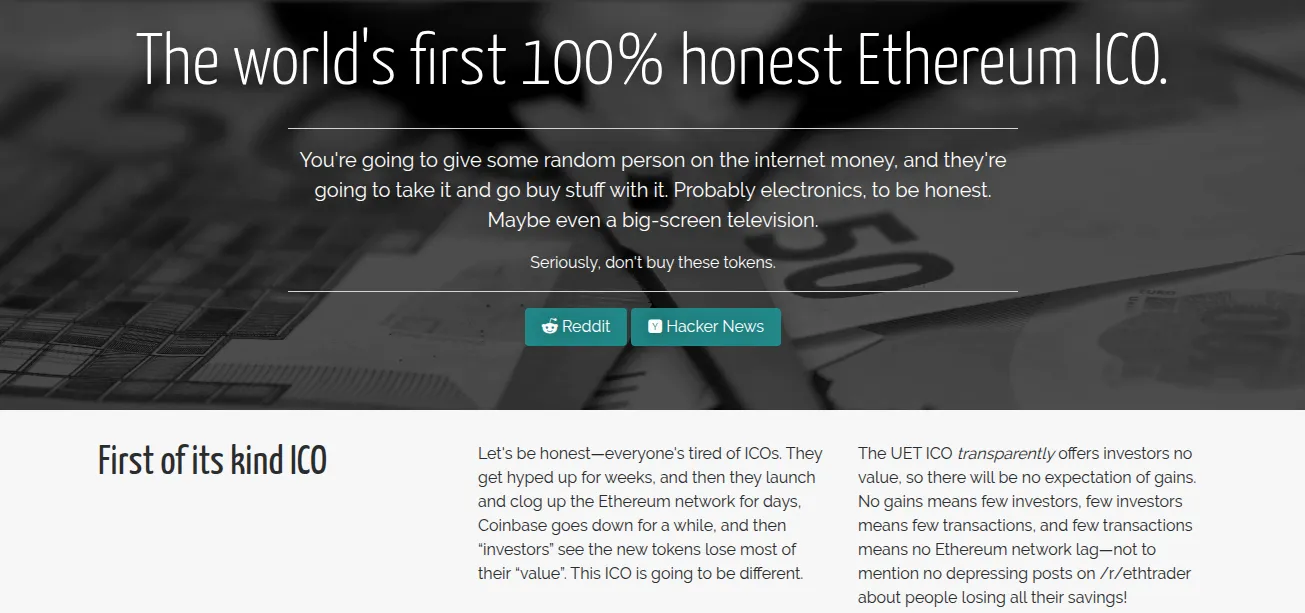
The developer bluntly warned that UET would have zero functionality and provide no benefits whatsoever — pure satire of the ICO hype. Paradoxically, people became interested anyway: during the ICO, investors still poured in money, and in less than a week the project raised over $250,000.
The UET creators were laughing at investors’ irrational faith in any new tokens — even when told point-blank that it was worthless. But the market showed they should have been capitalizing on the universal interest instead of just laughing.
Today — eight years later — we know all too well that token uselessness isn’t actually a drawback. Millions of tokens with no intended use case hit the market daily, yet some still get bought, and this is no longer a joke. Tokens that play with the very concept of uselessness (now in serious rather than satirical form) exist in the market and are doing just fine.
Jesus Coin (JC)
Jesus Coin was a parody of both religion and the “messianic” promises in the crypto world. The project launched in late 2017 as a satirical cryptocurrency offering to “delegate sins” and “decentralize Jesus.” The project’s whitepaper jokingly claimed that “Jesus would be happy to have his own coin,” with the goal of providing miracles exclusively to Jesus Coin holders. This way, the developers mocked both religious fervor and the grandiose promises of blockchain startups.

Originally, JC wasn’t supposed to have any value — it was pure trolling. However, at the height of the crypto boom, people were willing to buy even this token for novelty’s sake: someone first purchased Jesus Coin for 18.8 ETH (about $5,600 at the time), and the creators “accidentally made money” from their joke. Then things snowballed, and riding the wave of speculative fever, Jesus Coin briefly reached a market cap of $1.4 million.
Fartcoin (FARTCOIN)
Fartcoin is a token whose very name makes fun of itself, representing a grotesque joke about the “value of a fart.” This joke first appeared on the Bitcointalk forum on January 30, 2013. Someone proposed using Proof-of-Fart instead of Proof-of-Work: creating mining devices that would capture the unmistakable bodily sounds of their owners and use those moments to confirm blocks. The whole concept was based on toilet humor: Fartcoin transactions were supposed to be accompanied by animation and electronic fart sounds.
Back then, the idea never took off. It remained just verbal jokes. But in 2024, a meme token called Fartcoin appeared on the Solana blockchain. All that remained from those original jokes was the name, but even that proved enough to attract attention. During the new wave of meme coins, Fartcoin’s price skyrocketed. By January 2025, Fartcoin’s market cap exceeded $2 billion — more than the market value of many well-known real-world companies.
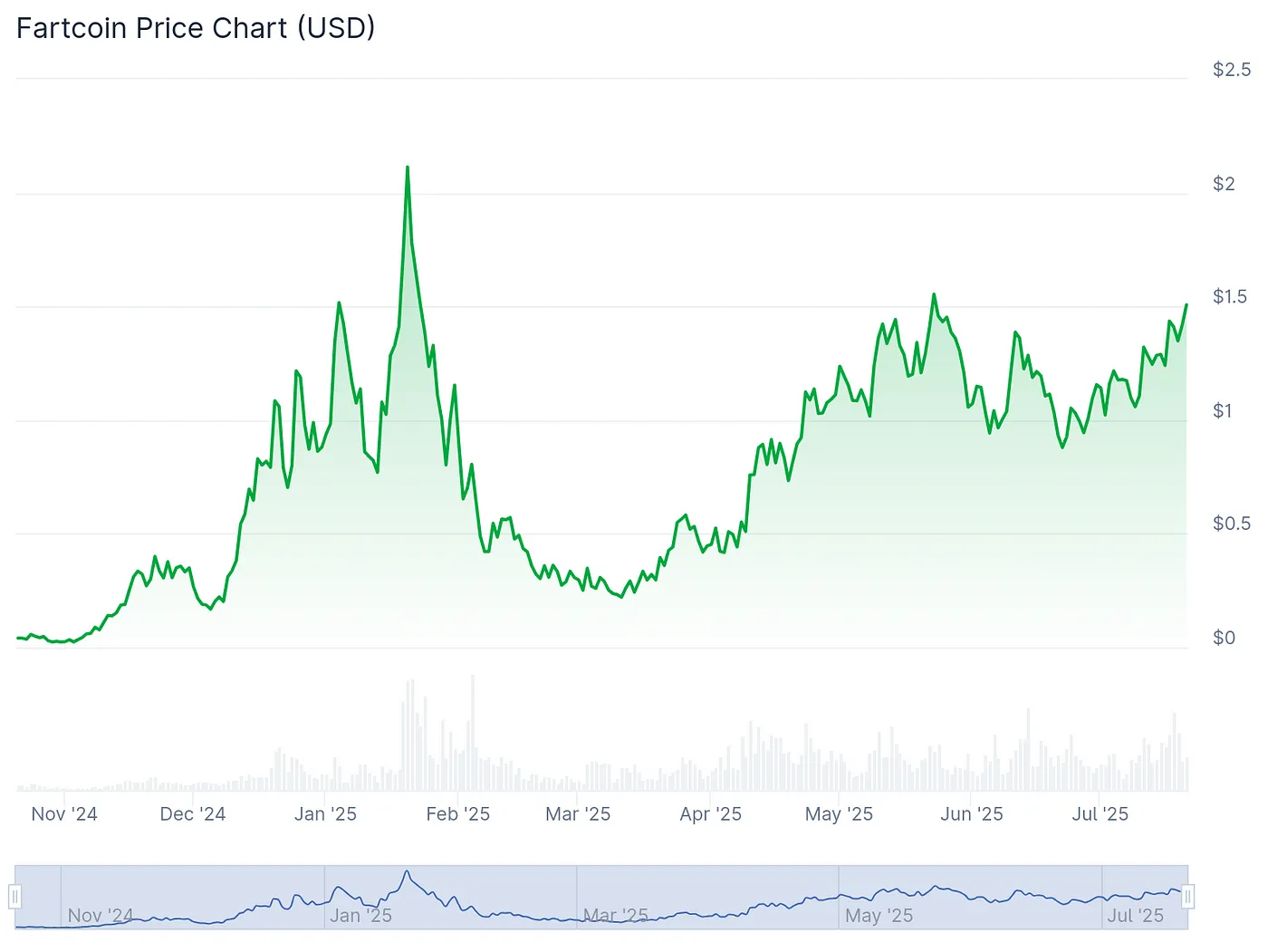
The crypto market’s enormous appetite for risk can lead to even the most “stinky” joke attracting gigantic capital when traders catch gambling fever.
Putin Classic (PUTIC)
In 2016, a trend emerged of using political leaders’ names in cryptocurrency titles. This trend continues today, but now you can find multiple different tokens exploiting the same politician’s name, whereas back then, if a cryptocurrency name was already taken, it wasn’t customary to repeat it.
The surname of Russian President Putin was among the first to appear in a cryptocurrency name: Putin Coin launched in 2016. But competing developers who missed out on that name decided to joke about something that was relevant to the crypto industry at the time. Ethereum Classic had just split off from Ethereum. So why not launch Putin Classic alongside Putin Coin? It would be fun!
And yes, it turned out to be fun. Putin Coin, which aimed to profit from the Russian president’s popularity, peaked at around $9 million market cap, while Putin Classic, which simply parodied processes happening in the crypto world, reached a comparable market cap of $6.8 million.
Even though its creators never planned to make money from it. They positioned PUTIC as a souvenir coin and urged people not to buy it, but to donate to the developers if they liked the idea.
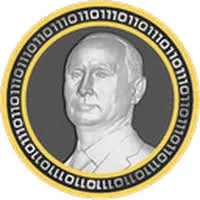
Putin Classic proved that sometimes the parody can be worth almost as much as the original — especially when the parody is funnier.
Dogelon Mars (ELON)
At the beginning of this article, I listed cryptocurrencies usually included in “jokes that took off” roundups: SHIB, BONK, MONA, PEPE, FLOKI. I said I don’t understand what’s funny about them. If the humor is the same as Dogecoin’s (memes instead of real value), then I’d argue that a joke repeated a thousand times stops being a joke.
Dogelon Mars mocks exactly this: parasiting off well-known trends when choosing a cryptocurrency name. Its name is a sarcastic cocktail of trending words: Dogecoin, Elon Musk, and To The Mars. (In 2021, when it launched, there was a brief popular idea that crypto wasn’t going to the moon, but much higher — straight to Mars.) The humor lay in ridiculing the chase for names and memes: let’s cram not just one reference into the name, but three at once!
The community embraced the joke enthusiastically — a significant fanbase quickly grew around Dogelon Mars, appreciating both the humor and the coin’s speculative potential. During the crypto frenzy of 2021, Dogelon Mars’ market cap twice jumped to $1.19 billion. At its peak, the coin entered the top 100 largest cryptocurrencies. Thus, Dogelon Mars transformed from a playful word combination into a crypto asset with a billion-dollar valuation (albeit briefly).

What Does This List Tell Us?
I wanted to run through successful jokes (successful in financial terms) to absorb their vibe and understand how to act now, when similar new jokes might start exploding.
So what is this vibe? What unites all these joke cryptocurrencies?
What they have in common is this: people started buying them unexpectedly, even for the developers themselves (the exception might be ELON, which was still a commercial joke after all).
Some cryptocurrencies were bought for hundreds of thousands of dollars, others for tens of billions. Then they crashed.
And here’s what’s interesting. Nobody knows how high the market will value any particular joke, or where this reversal will happen: at hundreds of thousands or tens of billions of dollars in market cap. But the general vibe is that a reversal will definitely happen, and it will be very sharp. Developers of joke cryptocurrencies might stay in the green, but most buyers probably won’t.

Digital art “I Hate Pepe the Frog” by Anna Shee.
I think this leads to the conclusion that joke cryptocurrencies are more profitable to create than to hunt for.
No, I’m not leading you toward me launching some RabbitCoin anytime soon. Besides, RabbitCoin already exists. I don’t know who created it, but I tip my hat to them. They came up with a great name, spotted the clever twist in it (RabBitcoin), and played on that. Beautifully done! While I have nothing to do with this RBTC token, I’d like to point out that it’s available at the best rates on the Rabbit Swap website.
If your sense of humor is intact — go for it, express it through cryptocurrencies. Creating a joke token takes just a couple of minutes these days. And as we can see, the crypto market knows how to reward good jokes.













